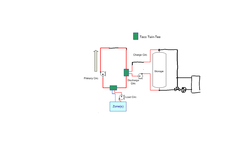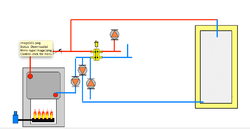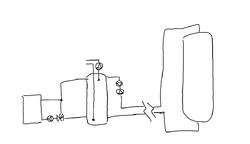A while back I remember some discussion about different approaches to getting proper flow direction into and out of storage in primary/secondary systems. There were approaches using 4-way valves, extra tees, double circulators with check valves, and a variety of variations.
I've spent some time reading, researching, and thinking about this problem.
My question for the collective wisdom of the forum: Is the approach shown below the simplest and least expensive way to get top-to-bottom flow through storage while charging and bottom-to-top flow while discharging in a primary/secondary loop system?

The green blocks are Taco twin tees - necessary for the storage connection since flow can go either way through the storage loop. The two storage circs face in opposite directions and don't have flow checks. During charge (putting heat into storage), the top circ is active and pushes water from the primary loop into the top of storage and then backwards through the inactive lower circ. When drawing heat from storage, only the lower circ is active and flow through the storage loop is reversed.
Any problems with this approach? Any better ways to do this?
Thanks.....
I've spent some time reading, researching, and thinking about this problem.
My question for the collective wisdom of the forum: Is the approach shown below the simplest and least expensive way to get top-to-bottom flow through storage while charging and bottom-to-top flow while discharging in a primary/secondary loop system?

The green blocks are Taco twin tees - necessary for the storage connection since flow can go either way through the storage loop. The two storage circs face in opposite directions and don't have flow checks. During charge (putting heat into storage), the top circ is active and pushes water from the primary loop into the top of storage and then backwards through the inactive lower circ. When drawing heat from storage, only the lower circ is active and flow through the storage loop is reversed.
Any problems with this approach? Any better ways to do this?
Thanks.....






